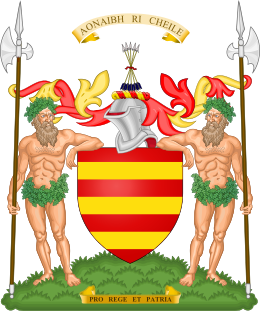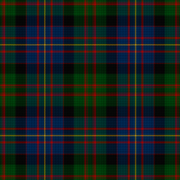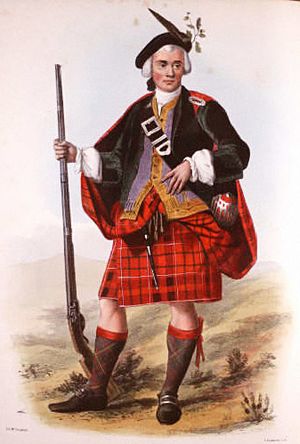Clan Cameron facts for kids
Quick facts for kids Clan Cameron |
|||
|---|---|---|---|
| Na Camshronaich | |||

Crest: A sheaf of five arrows, proper, tied with a band, gules, encircled by a belt and buckle.
|
|||
| Motto | Aonaibh Ri Chéile (Let Us Unite). | ||
| War cry | Chlanna nan con thigibh a' so 's gheibh sibh feòil (Sons of the Hounds, Come Hither And Get Flesh) | ||
| Profile | |||
| Region | Highlands | ||
| District | Lochaber | ||
| Plant badge | crowberry, or oak | ||
| Chief | |||
 |
|||
| Donald Angus Cameron of Lochiel | |||
| The 27th Chief of Clan Cameron (Mac Dhòmhnaill Dubh [maxkˈɣõː.əl̪ˠtuh]) | |||
| Seat | Achnacarry Castle | ||
| Historic seat | Tor Castle | ||
|
|||
|
|||
|
|||
|
|||
|
|||
Clan Cameron is a famous Scottish clan from the Highlands. Their lands are in Lochaber, a beautiful area that includes Ben Nevis, the tallest mountain in the British Isles. The leader of the clan is usually called "Lochiel."
Contents
- History of Clan Cameron
- Chiefs
- Castles
- Tartans
- Crests
- See also
History of Clan Cameron
Where Did the Clan Begin?
The exact start of Clan Cameron is a bit of a mystery, with a few ideas about how they began.
One popular story says the Camerons of Lochiel came from a person named Angus. He married Marion, whose father was the Thane of Lochaber. The first chief might have been called Cameron because of his "crooked nose" (cam-shròn in Gaelic). Giving people nicknames like this was common in old Gaelic culture.
Another idea suggests that Donald Dubh, who was the first truly recognized chief, came from a family in Fife.
How the Clan Grew Strong
Around the early 1400s, the Camerons became a powerful Highland clan in Lochaber. They likely grew stronger by marrying into a local family called Mael-anfhaidh. This family was known as "children of He who was Dedicated to the Storm."
By the 15th century, the Cameron family took over the leadership of Mael-anfhaidh. Other local families, like the MacMartins and MacGillonies, joined the growing Clan Cameron. Because of this, early Cameron chiefs were sometimes called "MacGillonay."
Since the 15th century, the chiefs have been known as Mac Dhomnuill Dubh. This name honors Donald Dubh, the first chief whose family line can be clearly traced. The clan was officially recognized by the name Cameron in 1472.
Fighting for Scottish Freedom
During the Wars of Scottish Independence, Clan Cameron bravely supported King Robert the Bruce. They fought against the English at the Battle of Bannockburn in 1314. Later, they also fought at the Battle of Halidon Hill in 1333.
Clan Conflicts in the 14th Century
A long-lasting feud began between Clan Cameron and Clan Mackintosh, who were part of the larger Chattan Confederation. This fight was over land and lasted for about 300 years.
The first recorded battle was the Battle of Drumlui in 1337. It was a dispute over land in Glenlui and Loch Arkaig.
This was followed by the Battle of Invernahoven in 1370, also against the Mackintoshes.
In 1396, the famous Battle of the North Inch took place. This was a special "trial by combat" where thirty warriors from Clan Cameron fought thirty from the Chattan Confederation.
Clan Conflicts in the 15th Century
In 1411, Clan Cameron fought at the Battle of Harlaw. They supported Domhnall of Islay, Lord of the Isles, who wanted to be the Earl of Ross.
The Camerons also fought at the Battle of Lochaber in 1429. This was against King James I of Scotland's army. Soon after, they fought the Mackintoshes again at the Battle of Palm Sunday.
In 1431, Clan Cameron fought at the Battle of Inverlochy (1431) against Clan Donald. The MacDonalds won this battle against the king's army. In 1439, the clan fought against the Clan Maclean at the Battle of Corpach.
Another battle with the Mackintoshes, the Battle of Craig Cailloc, happened in 1441.
In 1472, Alan MacDonald Dubh, the 12th Chief, became the constable of Strome Castle. He was later killed in 1480 while fighting the Mackintoshes.
In 1491, Clan Cameron took part in the Raid on Ross.
Clan Conflicts in the 16th Century
In 1505, the Battle of Achnashellach is said to have happened between the Camerons, Clan Munro, and Clan Mackay.
During the Anglo-Scottish Wars, the Clan Cameron chief, Ewen Cameron, and some of his men survived fighting the English at the Battle of Flodden in 1513.
In 1544, a fight over the leadership of Clan MacDonald of Clan Ranald led to the Battle of the Shirts. The Camerons helped the MacDonalds against the Clan Fraser of Lovat, who were defeated. After this, the Camerons raided the lands of Clan Grant and Clan Fraser. Because of his actions, Chief Ewen Cameron was executed in 1547.
The Battle of Bun Garbhain was fought in 1570. Donald Dubh Cameron, the 15th Chief, had died, leaving a young son, Allan, as the new chief. During this battle, the Chief of Mackintosh was reportedly killed by a Cameron warrior using a fearsome Lochaber axe.
In 1594, Allan Cameron, the 16th Chief, led the clan at the Battle of Glenlivet. They supported George Gordon, 1st Marquess of Huntly, who defeated the forces of Archibald Campbell, 7th Earl of Argyll.
17th Century and the Civil War
During the Civil War, at the Battle of Inverlochy in 1645, Clan Cameron fought alongside the Royalists. They helped defeat the Scottish Covenanters of Clan Campbell. The clan continued to oppose Oliver Cromwell and played a big part in Glencairn's rising from 1651 to 1654.
The Stand-off at the Fords of Arkaig in 1665 was a peaceful event. It finally ended the 328-year feud between the Camerons and the Chattan Confederation, led by Clan Mackintosh.
In 1668, Sir Ewen Cameron of Lochiel, the 17th Chief, worked to keep peace between his clan and Clan Mackintosh. However, while he was away, a feud started between Clan MacDonald and the Mackintoshes. The Camerons then helped the MacDonalds win against the Mackintoshes and Mackenzies at the Battle of Mulroy.
Clan Cameron fought as Jacobites in several battles: the Battle of Killiecrankie in 1689, the Battle of Dunkeld in 1689, and the Battle of Cromdale in 1690.
18th Century and Jacobite Risings
During the Jacobite rising of 1715, Clan Cameron supported the Jacobite cause. They fought at the Battle of Sheriffmuir. Later, they fought at the Battle of Glen Shiel in 1719. After this, the 18th Chief, John Cameron of Lochiel, went into exile in France. In 1724, it was estimated that the clan had about 800 fighting men.
When Charles Edward Stuart (Bonnie Prince Charlie) arrived in Scotland in 1745, he met Lochiel, the 19th Clan Chief. Lochiel promised his clan's full support. Many believe the Jacobite rising of 1745 might not have happened without the Camerons joining. Clan Cameron fought bravely at the Battle of Prestonpans (1745), Battle of Falkirk (1746), and on the front lines at the Battle of Culloden (1746). After Culloden, Donald Cameron of Lochiel, known as Gentle Lochiel, escaped to France, where he died in 1748.
Jean Cameron of Glendessary, called 'Bonnie Jean Cameron', was a famous Jacobite supporter. She was a cousin of Lochiel. The MacMartins, a sept of the clan, were also very loyal to Lochiel and fought in the 1745 rising.
Two other prominent Camerons, John Du Cameron (known as Sergeant Mor) and Dr Archibald Cameron of Lochiel (the chief's brother), were captured and executed in 1753 for their Jacobite activities.
The 79th (The Queen's Own Cameron Highlanders) Regiment of Foot was formed from clan members in 1793. It was raised by Sir Alan Cameron of Erracht.
Colonel John Cameron (1771–1815) was another important military leader. His family became baronets because of his success in battle.
Charles Cameron (1745–1812) was a famous architect in Imperial Russia. He designed buildings like Tsarskoye Selo and Pavlovsk Palace. He claimed to be from the Lochiel family.
19th and 20th Centuries
Highland Clearances
After the Battle of Culloden, Clan Cameron's land was taken by the government. In 1784, it was given back to Donald Cameron 22nd of Lochiel, who was only 15. The land was managed by a group until 1819.
The first "clearance" happened in 1801 at Clunes. This was when people were moved off their land. Many Camerons moved away, especially to Canada, starting in 1802. These clearances continued under Donald Cameron when he took over in 1819.
The Clan Cameron Museum at Achnacarry shows the history of the clan, including details about the clearances.
Some traditional Cameron land was not returned in 1784. This land was controlled by the Duke of Gordon from 1770. He raised rents and cleared the land with the help of his agent, the Revd John Anderson. These clearances continued until 1806.
Many Camerons around the world today can trace their family history back to those who were moved from their homes during the Highland Clearances.
Napoleonic Wars
During the Revolutionary and Napoleonic Wars, John Cameron of Fassiefern fought bravely from 1793. He was killed leading the 92nd Regiment at Quatre Bras, just two days before the Battle of Waterloo.
Donald Cameron of Lochiel, the 23rd Chief, also fought with distinction at the Battle of Waterloo.
World War I
During World War I, Sir Donald Walter Cameron of Lochiel, the 25th Chief, helped create four more battalions of the Queen's Own Cameron Highlanders.
World War II
The Cameron Highlanders were famously the last battalions to wear the kilt in battle. This was because their commanders delayed orders to change uniforms. They also faced a surprise German attack, which they successfully fought off. Because of this, they earned the nickname 'Ladies from Hell'.
Sir Donald Hamish Cameron of Lochiel, the 26th Chief, served with the Cameron Highlanders.
Chiefs
Castles
- Tor Castle: Ewen Cameron, the 13th Chief, rebuilt "Tor Castle" in the early 1400s. His great-great-great-grandson, Sir Ewen "Dubh" Cameron of Lochiel, the 17th Chief, later left it. Tor Castle was used by the Camerons as a safe place from attacks by the Clan MacDonald of Keppoch.
- Achnacarry Castle: Chief Sir Ewen built Achnacarry Castle around 1655. It was burned down by government forces after the Battle of Culloden in 1746. In 1802, Donald Cameron, the 22nd Chief, built a new house at Achnacarry. He had to pay a large fine to get his family's lands back. The house is still there today. There is also a museum nearby, started in 1989.
- The Camerons of Lochiel also had a castle on Eilean nan Craobh (Tree Island) in the 1500s and 1600s.
Tartans
There are several tartans for Clan Cameron.
| Tartan image | Notes |
|---|---|
 |
Clan Cameron tartan, published in 1845. |
 |
Cameron of Erracht tartan; it was the official tartan for the 79th Regiment. |
Other Cameron tartans include:
- Basic Clan Cameron
- Cameron of Lochiel
- Hunting Cameron (of Lochiel)
Crests
Clan Cameron has two main crests that members can wear. One is the original "Dexter Arm" crest. The other is the "Five Arrows" crest. This crest shows five arrows tied together, representing the five main branches of the clan united under the leadership of the Camerons of Lochiel.
The five branches are:
- The MacMartins or Camerons of Letterfinlay
- The Camerons of Glen Nevis
- The Camerons of Callart and Lundavra
- The Camerons of Erracht
- The Camerons of Clunes
See also
- Cameron (disambiguation)
- Battle of Culloden
- Jacobite risings
- Eilean Munde
- Lochaber axe
- Cateran



